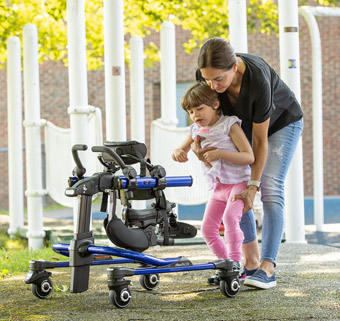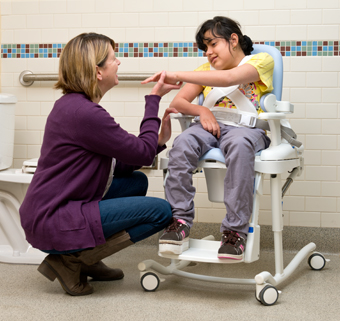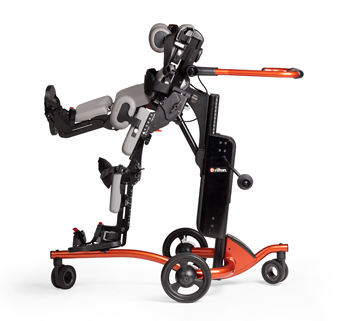A New Clinical Practice Guideline for Functional Interventions for Children with CP
| November 2021 Children with cerebral palsy (CP) benefit from functional interventions that seek to improve activity and participation levels within their daily environments. An excellent new study provides clinical practice guidelines at the activities and participation level of the International Classification of Functioning, Disability and Health (ICF) to families and therapists, addressing which interventions are effective and evidence-based. The study, Interventions to improve physical function for children and young people with cerebral palsy: international clinical practice guideline, evaluated systematic reviews (or other supplementary evidence where a systematic review was unavailable) to draft a list of Good Practice Recommendations and Evidence-Based Practice Recommendations.
Children with cerebral palsy (CP) benefit from functional interventions that seek to improve activity and participation levels within their daily environments. An excellent new study provides clinical practice guidelines at the activities and participation level of the International Classification of Functioning, Disability and Health (ICF) to families and therapists, addressing which interventions are effective and evidence-based. The study, Interventions to improve physical function for children and young people with cerebral palsy: international clinical practice guideline, evaluated systematic reviews (or other supplementary evidence where a systematic review was unavailable) to draft a list of Good Practice Recommendations and Evidence-Based Practice Recommendations.
Good Practice Recommendations (1–9)
The nine Good Practice Recommendations are based on clinical reasoning and decision making and apply to questions outside the scope of available systematic reviews. These consider the child and family preferences, environment and economic standing, in order to appropriately implement the evidence for best outcomes. The recommendations are as follows:
- Goals should be client-chosen.
- Clinicians should determine the factors that are limiting goal achievement.
- Intervention should directly target the child’s chosen goals.
- Intervention should be enjoyable and motivating for the child.
- Practice of goals should occur within the child’s home or community environments.
- Parent-delivered intervention is a key component of all intervention.
- Children and young people and parents should remain the decision-makers throughout.
- Enough practice needs to be undertaken to achieve functional goals.
- A team approach should be used to set goals and intervention regimens.
Evidence-Based Practice Recommendations (10–13)
A multidisciplinary panel using the GRADE Evidence to Decision framework developed the four Evidence-Based Practice Recommendations after rigorous examination of pertaining interventions and the evidence supporting them. The process included deciding for or against a recommendation (benefit versus harm) and then indicating the strength of the recommendation (strong or conditional). The recommendations are as follows:
- Gross motor function and mobility (children with CP, GMFCS levels I–IV)
There is a strong recommendation for task-based, contextual mobility practice and a high certainty of harm with no intervention.
The most effective means to improving walking speed and distance is by practicing walking. Treadmill training can increase the dose of walking practice, and overground gait training has best outcomes when practiced within a child’s everyday environment.
Children in GMFCS levels IV and V show more improvement in ambulation distance when walking overground compared to treadmill practice.
Gross motor function should be practiced as a whole-task, although part-task practice may be a stepping stone.
For children in GMFCS levels III and IV, adaptive equipment, environmental adaptations and technology support progress to functional goals, independence and inclusion.
- Hand use in functional activities
There is a strong recommendation, based on a low to high certainty of evidence, for improving hand use through whole-task practice with a task-oriented approach.
CIMT and bimanual therapy (HABIT/HABIT-ILE) are effective approaches for their intended clinical presentations, and both should be followed by whole-task practice (without restraint after CIMT).
- Self-care
There is a strong recommendation, based on a high certainty of harm from no intervention, for self-care goals. Once again, these should be practiced with a task-specific approach, using adaptive equipment to aid in their achievement.
- Leisure
This is a conditional recommendation with a lower certainty of evidence. However, most individuals would choose to participate in leisure activities regardless. Performance of leisure activities is best done with a goal-oriented approach and a focus on overcoming barriers to participation.
Certainly, reading the entire article is time well spent, as each evidence-based recommendation comes with intervention and population-specific details. It is great to see such a wealth of evidence supporting a task-based, contextual approach for improving activities and participation for children with disabilities. And of course, as this is the first clinical practice guideline to describe both physical therapy and occupational therapy interventions for children with cerebral palsy under the ICF’s activities and participation levels, it is a most welcome addition to pediatric literature.
Reference
Jackman M, Sakzewski L, Morgan C, Boyd RN, Brennan SE, Langdon K, et al. Interventions to improve physical function for children and young people with cerebral palsy: international clinical practice guideline. Dev Med Child Neurol. 2021. DOI: 10.1111/dmcn.15055.







